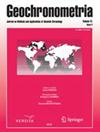Electron Spin Resonance (ESR) Signal Intensity of Quartz E1′ Centre and Its Potential Use in Fluvial Sediments Provenance Tracing
IF 0.9
4区 地球科学
Q3 Earth and Planetary Sciences
引用次数: 0
Abstract
Abstract To assess if the heat-treated E1′ centre in quartz is suitable for fluvial sediment provenance tracing, eight granitic samples from sediments and their source rocks with distinct geological ages and origins were collected for electron spin resonance (ESR) measurements. The results show that the maximum heat-treated E1′ signal intensity of quartz in the fluvial sediments occurs upon heating at about 300°C, as previously observed in aeolian quartz. The heat-treated E1′ signal intensity of quartz in sediment samples also shows significant correspondence to those of their source rocks as well as their formation age. We propose that the heat-treated E1′ centre of sedimentary quartz, combined with other lithological discrimination parameters, could serve as an effective indicator for fluvial sediment provenance tracing.石英E1′中心电子自旋共振(ESR)信号强度及其在河流沉积物物源示踪中的潜在应用
摘要为了评估石英中热处理的E1′中心是否适合河流沉积物物源追踪,从具有不同地质年龄和来源的沉积物及其源岩中采集了8个花岗岩样品进行电子自旋共振(ESR)测量。结果表明,河流沉积物中石英的最大热处理E1′信号强度发生在约300°C的加热时,正如之前在风成石英中观察到的那样。沉积物样品中石英经热处理后的E1′信号强度也与其源岩的信号强度及其形成年代显著对应。我们提出,沉积石英的热处理E1′中心,结合其他岩性判别参数,可以作为河流沉积物物源追踪的有效指标。
本文章由计算机程序翻译,如有差异,请以英文原文为准。
求助全文
约1分钟内获得全文
求助全文
来源期刊

Geochronometria
地学-地球科学综合
CiteScore
2.20
自引率
0.00%
发文量
1
审稿时长
>12 weeks
期刊介绍:
Geochronometria is aimed at integrating scientists developing different methods of absolute chronology and using them in different fields of earth and other natural sciences and archaeology. The methods in use are e.g. radiocarbon, stable isotopes, isotopes of natural decay series, optically stimulated luminescence, thermoluminescence, EPR/ESR, dendrochronology, varve chronology. The journal publishes papers that are devoted to developing the dating methods as well as studies concentrating on their applications in geology, palaeoclimatology, palaeobiology, palaeohydrology, geocgraphy and archaeology etc.
 求助内容:
求助内容: 应助结果提醒方式:
应助结果提醒方式:


